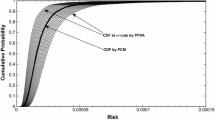Abstract
In the field of risk assessment, one of the main aspects is the frequency of accident circumstances. Generally, the risk assessment evaluation is done using generic frequency approach. In case of accident, human factors associated with assigning the impact and cause of the hazard is not considered. Rather more focus is given to generic frequency approach which does not explicitly use the human factors. The main reason behind ignoring this factor primarily lies in the fact that its inclusion makes the entire procedure more complex. However, the proposed fuzzy logic approach helps in achieving the associated complexities in risk computation when we include human factors.
Access this chapter
Tax calculation will be finalised at checkout
Purchases are for personal use only
Similar content being viewed by others
References
Health and Safety Executive (HSE). Failure rate and event data for use within risk assessments. http://www.hse.gov.uk/landuseplanning/failure-rates.pdf(03.12.12) (2012)
Dan, J.G., Arnaldos, J., Darbra, R.M.: Introduction of the human factors in the estimation of accident frequencies through fuzzy logic. Saf. Sci. J. (2017)
Health and Safety Executive (HSE). Managing Contractors: A Guide for Employers. http://www.hse.gov.uk/pubns/priced/hsg159.pdf(16.11.12) (2011)
Jang, J.: Fuzzy Inference Systems. Prentice-Hall, NJ (1997)
Health and Safety Executive (HSE). Human factors in the management of major accident hazards. http://www.hse.gov.uk/humanfactors/topics/toolkitintro.pdf(17.11.12) (2005)
Klir, G.J., Yuan, B.: Fuzzy Sets and Fuzzy Logic: Theory and Applications. Prentice-Hall, NJ (1995)
Nait-Said, R., Zidani, F., Ouzraoui, N.: Fuzzy risk graph model for determining safety integrity level. Int. J. Qual. Stat. Reliab. 112 (2008)
Nair, J.J., Govindan, V.K.: Automatic segmentation employing fuzzy connectedness. Inter. Rev. Comput. Softw. 7 (2012)
Mathew, R., Kaimal, M.R.: A fuzzy approach to the 2 × 2 games and an analysis of the game of chicken. Inter. J. Knowl. Based Intell. Eng. Syst. 8(4), 181–188 (2004)
Mohanlal, P.P., Kaimal, M.R.: Design of optimal fuzzy observer based on TS fuzzy model. In: Fuzz IEEE (2004)
Author information
Authors and Affiliations
Corresponding author
Editor information
Editors and Affiliations
Rights and permissions
Copyright information
© 2020 Springer Nature Singapore Pte Ltd.
About this paper
Cite this paper
Vijayan, A., Kumar, A.S., Narayanan, J. (2020). Fuzzy Logic: Adding Personal Attributes to Estimate Effect of Accident Frequencies. In: Dash, S., Lakshmi, C., Das, S., Panigrahi, B. (eds) Artificial Intelligence and Evolutionary Computations in Engineering Systems. Advances in Intelligent Systems and Computing, vol 1056. Springer, Singapore. https://doi.org/10.1007/978-981-15-0199-9_40
Download citation
DOI: https://doi.org/10.1007/978-981-15-0199-9_40
Published:
Publisher Name: Springer, Singapore
Print ISBN: 978-981-15-0198-2
Online ISBN: 978-981-15-0199-9
eBook Packages: Intelligent Technologies and RoboticsIntelligent Technologies and Robotics (R0)




